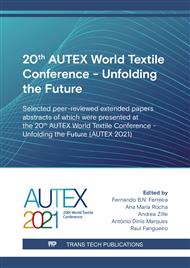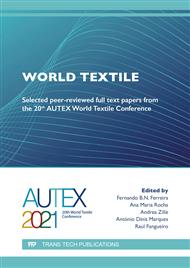[1]
Tärneberg, S., Lehmann, M., Eder-Hansen, J., Kruse, E., & Chalmer, C. CEO Agenda 2019: Eight Sustainability Priorities for the Fashion Industry. (2019).
Google Scholar
[2]
Vezzoli, C., Kohtala, C., Srinivasan with Diehl, A. J., Moi Fusakul, S., Xin, L., & Sateesh Vezzoli, D. Product-Service System Design for Sustainability (LenS, Ed.). Greenleaf Publishing Limited. (2014) www.greenleaf-publishing.com.
DOI: 10.4324/9781351278003
Google Scholar
[3]
Bocken, N. M. P., de Pauw, I., Bakker, C., & van der Grinten, B. Product design and business model strategies for a circular economy. Journal of Industrial and Production Engineering, 33(5), 308–320. (2016) https://doi.org/10.1080/21681015.2016.1172124.
DOI: 10.1080/21681015.2016.1172124
Google Scholar
[4]
Ellen MacArthur Foundation. Circularity Indicators - An Approach to Measuring Circularity. (2015) http://www.ellenmacarthurfoundation.org/circularity-indicators/.
Google Scholar
[5]
Kozlowski, A., Searcy, C., & Bardecki, M. The reDesign canvas: Fashion design as a tool for sustainability. Journal of Cleaner Production, 183, 194–207. (2018) https://doi.org/10.1016/j.jclepro.2018.02.014.
DOI: 10.1016/j.jclepro.2018.02.014
Google Scholar
[6]
Sampaio, C. P. de, Trein, F. A., Santos, A. dos, Lopes, C. S. D., Chaves, L. I., Librelotto, L. I., Ferroli, P. C. M., Lepre, P. R., Engler, R. C., Martins, S. B., & Nunes, V. G. A. Design para a Sustentabilidade - Dimensão Ambiental (E. Insight, Ed.; Primeira e). Lens Brazil. (2018).
Google Scholar
[7]
Calabrese, A., Forte, G., & Ghiron, N. L. Fostering sustainability-oriented service innovation (SOSI) through business model renewal: The SOSI tool. Journal of Cleaner Production, 201, 783–791. (2018) https://doi.org/10.1016/j.jclepro.2018.08.102.
DOI: 10.1016/j.jclepro.2018.08.102
Google Scholar
[8]
Ezio Manzini, & Carlo Vezzoli. Product-Service Systems and Sustainability Opportunities for sustainable solutions. (2002) http://hdl.handle.net/20.500.11822/8123.
Google Scholar
[9]
Copani, G., & Behnam, S. CIRP Journal of Manufacturing Science and Technology Remanufacturing with upgrade PSS for new sustainable business models. CIRP Journal of Manufacturing Science and Technology. (2018) https://doi.org/10.1016/j.cirpj.2018.10.005.
DOI: 10.1016/j.cirpj.2018.10.005
Google Scholar
[10]
Simons, Helen. Case Study Research in Practice. Los Angeles: Sage Publications. (2012).
Google Scholar
[11]
Fletcher, K. Sustainable Fashion & textiles - Design Journeys (Earthscan, Ed.). Earthscan. (2008).
DOI: 10.2752/175693809x469229
Google Scholar



